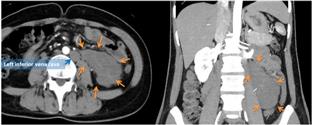| Abstract: | 
IntroductionGanglioneuromas are rare benign tumors originating from neural crests and typically affect young adults. The most frequent locations are the posterior mediastinum, retroperitoneum and adrenal gland. In general, retroperitoneal ganglioneuromas are discovered incidentally or by mass effect. In the literature, the number of retroperitoneal masses reported is quite limited. We report a case of laparoscopic excision of a retroperitoneal ganglioneuroma.Presentation of caseThe patient was a 40-year-old woman who visited a nearby clinic with anorexia and vomiting. She was referred to our hospital after the detection of an abdominal mass.Enhanced computed tomography(CT) showed a lobule mass of 107 × 42 mm in size, with internal inhomogeneity and mild delayed enhancement on the retroperitoneal side of the left abdominal lesion. Magnetic resonance imaging(MRI) showed a mass with low intensity and partial high intensity on T2 weighted Image (T2WI). In addition, positron emission tomography CT(PET-CT) detected slight fluorodeoxyglucose (FDG) accumulation (standardized uptake value(SUV) max: 3.01) in the same lesion. Based on these findings, we suspected a retroperitoneal tumor. Laparoscopic excision was performed via 5 ports. The extracted tissue was a well-defined mass of 110 × 70 mm. The tumor in our case exceeded 10 cm.The pathological diagnosis was ganglioneuroma, with no obvious malignancy.DiscussionIt was suggested that adaptation of laparoscopic surgery should be considered based on the observation of organ invasion or vessel invasion and adhesion around the tumor, rather than based on the diameter of the tumor.ConclusionThis approach is less invasive than conventional laparotomy methods and achieves good cosmetic outcomes. Thus, totally laparoscopic procedures should be considered more often for the treatment of retroperitoneal tumors. |

